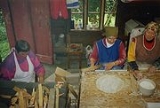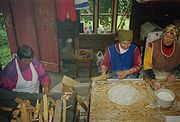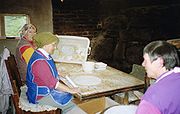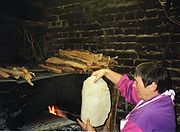
Krotekaker
Encyclopedia
Krotekaker is a traditional flatbread
from the Hardanger
region of Norway
. Outside of the region it is often known as hardangerkaker. The dried krotekaker can be made in quantity and stored without refrigeration for extended periods of time. Krotekake is a kind of lefse
thin pastry. The name lefse covers many different kinds of thin or thick, soft or hard pastry. In the Norwegian language krote means "a scroll" and kake is a cake or pastry. A common misunderstanding is that all kind of lefse contains potatoes.
The making of krotekaker is more than a recipe. It is an opportunity for small gatherings of neighbors in this largely rural fjord coastline. There are typically three or four participants in this activity. The preparation and assembly can take much of the day and provides plenty of time to share stories and catch up on neighborhood information while producing a bounty of staple foodstuff.
yeast dough
and let it rise. One member of the team can often perform this basic step before the arrival of the rest of the participants.
The biscuit maker measures and forms the dough. A handful of dough approximately 1.5 inches (3.8 cm) in diameter is pulled from the whole. This is formed by turning the edges of the dough-ball down and tucking them into the middle of the bottom of the ball. If the ball feels sticky, the biskit maker adds a dusting of flour. A ball is formed which has been pulled smooth on top and has a dimple on the bottom. The ball is then placed on the floured surface - dimple down. The biscuit maker should have one or two of these finished balls ready so that they have a minute or two to rest before they are rolled.

 The roller is responsible for shaping the round. A biscuit is rolled with a smooth round rolling pin until it is three or four inches (102 mm) in diameter and about 1/2 inch (125 mm) thick. It is then flipped over and rolled again until it is larger and thinner and shaped like a disk. At no time should the round stick to the pin or the table. If it appears to be getting sticky it should be flipped onto a new dusting of flour. The round is flipped and rolled and dusted until it is about 1/8 inch thick and twelve inches (305 mm) in diameter. If the round ends up sticking it needs to be scraped off the table or pin and placed back with the mass of dough.
The roller is responsible for shaping the round. A biscuit is rolled with a smooth round rolling pin until it is three or four inches (102 mm) in diameter and about 1/2 inch (125 mm) thick. It is then flipped over and rolled again until it is larger and thinner and shaped like a disk. At no time should the round stick to the pin or the table. If it appears to be getting sticky it should be flipped onto a new dusting of flour. The round is flipped and rolled and dusted until it is about 1/8 inch thick and twelve inches (305 mm) in diameter. If the round ends up sticking it needs to be scraped off the table or pin and placed back with the mass of dough.
Next the round is rolled with a special steel rolling pin
. The pin has deep grooves about 1/8 inch wide and 1/8 inch apart. It is also cut laterally at 1/8 inch intervals. The pin presses creases into the round but because of the lateral grooves it does not cut the round into ribbons of dough. This pin is firmly rolled across the round and then again at right angles to the original direction leaving a cross-hatch pattern which seals the top and bottom surfaces of the round to each other. The round may also be slightly sealed to the tabletop. A lefse stick
is a thin, flat, wooden stick with straight sides about 2 foot (0.6096 m) long and 1½ inches wide which has been sanded smooth. This stick is used to slide under the krotekake to release it from the floured surface. It is also used to scrape the table or pin clean of dough.

 The same person who rolls the biscuit thin usually cuts the round with the Hardanger pin. Since the making of krotekake is a social event as well as a cooking technique, the role of using this special pin is sometimes delegated to a guest or child who is just learning the tradition.
The same person who rolls the biscuit thin usually cuts the round with the Hardanger pin. Since the making of krotekake is a social event as well as a cooking technique, the role of using this special pin is sometimes delegated to a guest or child who is just learning the tradition.
The cook takes the scored round from the table and places it on a hot (~400 °F) flat grill. The cook is responsible for grill temperature which be determined by the amount of time a drop of water takes to boil off. The grill is not oiled but relies on an excess of flour to prevent any sticking. The burnt flour must be periodically brushed off. In a traditional oven, the round must be tossed onto the grill since there is no room to place it carefully.
Each of these steps takes approximately the same amount of time. This means the team can get into a rhythm where their work and conversation are in sync. A fourth member if available usually stacks the drying product, and divides it into shares for the participants. Team members can frequently exchange roles depending on their preferences.

Slowly add white flour until dough is workable
Roll out biskets on floured surface until thin, cut with Hardanger roller.
Dry bake on a flat griddle until lightly brown. When one side has cooked (about 1 minute), flip it and cook the other. Let dry.
May be stored up to six months.
In Hardanger Norway many dwellings have a special arched oven in a separate building in which the Krotekaker is cooked. The separate building is a guard against a house fire. The arched oven reflects the heat of the fire and so the Krotekaker cooks on both sides at the same time. There is no need to flip it.
Flatbread
A flatbread is a simple bread made with flour, water, and salt and then thoroughly rolled into flattened dough. Many flatbreads are unleavened: made without yeast or sourdough culture: although some flatbread is made with yeast, such as pita bread....
from the Hardanger
Hardanger
Hardanger is a traditional district in the western part of Norway, dominated by the Hardangerfjord. It consists of the municipalities of Odda, Ullensvang, Eidfjord, Ulvik, Granvin, Kvam and Jondal, and is located inside the county of Hordaland....
region of Norway
Norway
Norway , officially the Kingdom of Norway, is a Nordic unitary constitutional monarchy whose territory comprises the western portion of the Scandinavian Peninsula, Jan Mayen, and the Arctic archipelago of Svalbard and Bouvet Island. Norway has a total area of and a population of about 4.9 million...
. Outside of the region it is often known as hardangerkaker. The dried krotekaker can be made in quantity and stored without refrigeration for extended periods of time. Krotekake is a kind of lefse
Lefse
Lefse is a traditional soft, Norwegian flatbread. Lefse is made out of potato, milk or cream and flour, and cooked on a griddle. Special tools are available for lefse baking, including long wooden turning sticks and special rolling pins with deep grooves.-Flavoring:There are many ways of...
thin pastry. The name lefse covers many different kinds of thin or thick, soft or hard pastry. In the Norwegian language krote means "a scroll" and kake is a cake or pastry. A common misunderstanding is that all kind of lefse contains potatoes.
The making of krotekaker is more than a recipe. It is an opportunity for small gatherings of neighbors in this largely rural fjord coastline. There are typically three or four participants in this activity. The preparation and assembly can take much of the day and provides plenty of time to share stories and catch up on neighborhood information while producing a bounty of staple foodstuff.
Process and Roles
The first step in the process is to mix a simple whole-wheatWhole grain
Whole grains are cereal grains that contain cereal germ, endosperm, and bran, in contrast to refined grains, which retain only the endosperm. Whole grains can generally be sprouted while refined grains generally will not sprout. Whole-meal products are made by grinding whole grains in order to make...
yeast dough
Dough
Dough is a paste made out of any cereals or leguminous crops by mixing flour with a small amount of water and/or other liquid. This process is a precursor to making a wide variety of foodstuffs, particularly breads and bread-based items , flatbreads, noodles, pastry, and similar items)...
and let it rise. One member of the team can often perform this basic step before the arrival of the rest of the participants.
The biscuit maker measures and forms the dough. A handful of dough approximately 1.5 inches (3.8 cm) in diameter is pulled from the whole. This is formed by turning the edges of the dough-ball down and tucking them into the middle of the bottom of the ball. If the ball feels sticky, the biskit maker adds a dusting of flour. A ball is formed which has been pulled smooth on top and has a dimple on the bottom. The ball is then placed on the floured surface - dimple down. The biscuit maker should have one or two of these finished balls ready so that they have a minute or two to rest before they are rolled.


Next the round is rolled with a special steel rolling pin
Rolling pin
thumb|A wooden "roller" type rolling pinA rolling pin is a cylindrical food preparation utensil used to shape and flatten dough. Two styles of rolling pins are found; roller and rods. Roller types consists of a thick cylindrical roller with small handles at each end; rod type rolling pins are...
. The pin has deep grooves about 1/8 inch wide and 1/8 inch apart. It is also cut laterally at 1/8 inch intervals. The pin presses creases into the round but because of the lateral grooves it does not cut the round into ribbons of dough. This pin is firmly rolled across the round and then again at right angles to the original direction leaving a cross-hatch pattern which seals the top and bottom surfaces of the round to each other. The round may also be slightly sealed to the tabletop. A lefse stick
Scraper (kitchen)
There are several types of kitchen implements which are termed scrapers. They can be made of metal, plastics such as polyethylene, nylon, or polypropylene, wood, rubber or silicone rubber...
is a thin, flat, wooden stick with straight sides about 2 foot (0.6096 m) long and 1½ inches wide which has been sanded smooth. This stick is used to slide under the krotekake to release it from the floured surface. It is also used to scrape the table or pin clean of dough.


The cook takes the scored round from the table and places it on a hot (~400 °F) flat grill. The cook is responsible for grill temperature which be determined by the amount of time a drop of water takes to boil off. The grill is not oiled but relies on an excess of flour to prevent any sticking. The burnt flour must be periodically brushed off. In a traditional oven, the round must be tossed onto the grill since there is no room to place it carefully.
Each of these steps takes approximately the same amount of time. This means the team can get into a rhythm where their work and conversation are in sync. A fourth member if available usually stacks the drying product, and divides it into shares for the participants. Team members can frequently exchange roles depending on their preferences.
Ingredients

- 9 cups water warm (dissolve the yeast in the warm water)
- 2 packages yeast
- 3 cups Graham Flour
Slowly add white flour until dough is workable
- 1/2 cup brown sugar
- 2 eggs
- 1/2 cup Crisco
- 1 tablespoon salt
Directions
Mix all ingredients, let rise twice, Form biscuits out of the dough by taking a ball, approx 1½ inch diameter and folding the edges toward the bottom until the top is smooth.Roll out biskets on floured surface until thin, cut with Hardanger roller.
Dry bake on a flat griddle until lightly brown. When one side has cooked (about 1 minute), flip it and cook the other. Let dry.
May be stored up to six months.
In Hardanger Norway many dwellings have a special arched oven in a separate building in which the Krotekaker is cooked. The separate building is a guard against a house fire. The arched oven reflects the heat of the fire and so the Krotekaker cooks on both sides at the same time. There is no need to flip it.
External links
- Godt for ganen (Norwegian)

